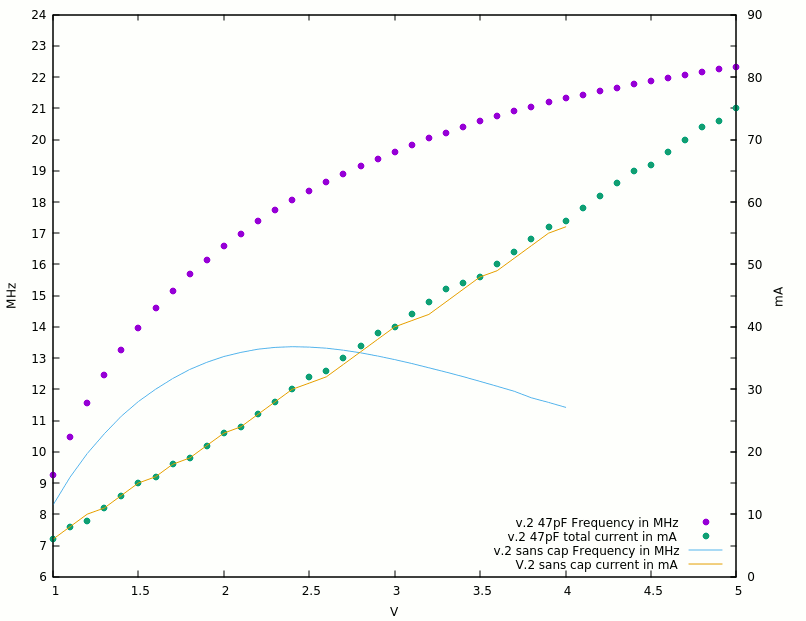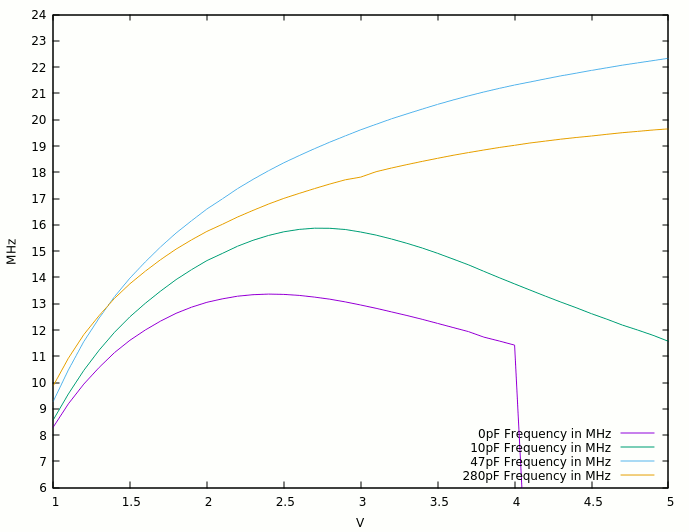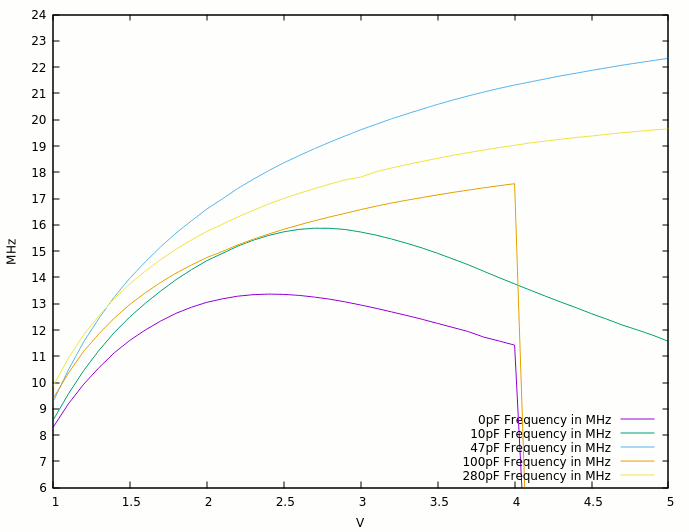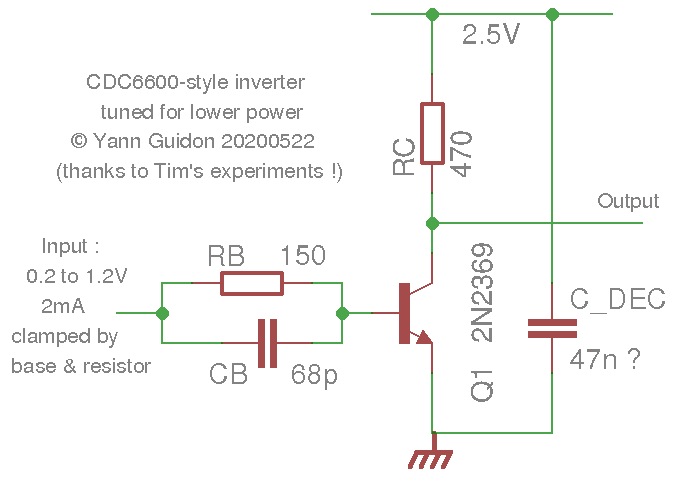a few minutes of soldering bring the base capacitors to the board... and once again Tim's curves are confirmed !

The data :
V mA MHz 1 6 9.263 1.1 8 10.481 1.2 9 11.560 1.3 11 12.456 1.4 13 13.268 1.5 15 13.974 1.6 16 14.592 1.7 18 15.166 1.8 19 15.692 1.9 21 16.156 2 23 16.603 2.1 24 16.985 2.2 26 17.381 2.3 28 17.731 2.4 30 18.056 2.5 32 18.360 2.6 33 18.634 2.7 35 18.899 2.8 37 19.150 2.9 39 19.386 3 40 19.617 3.1 42 19.828 3.2 44 20.036 3.3 46 20.223 3.4 47 20.406 3.5 48 20.585 3.6 50 20.750 3.7 52 20.906 3.8 54 21.057 3.9 56 21.191 4 57 21.322 4.1 59 21.435 4.2 61 21.552 4.3 63 21.666 4.4 65 21.771 4.5 66 21.877 4.6 68 21.976 4.7 70 22.073 4.8 72 22.163 4.9 73 22.251 5 75 22.337
The script :
set xlabel 'V'
set ylabel 'MHz'
set y2label 'mA'
set xr [1:5]
set yr [6:24]
set y2r [0:90]
set ytics 1
set y2tics 10
set key right bottom
plot "ringo9_2_47pF.dat" using 1:3 title "v.2 47pF Frequency in MHz" w points pt 7, \
"ringo9_2_47pF.dat" using 1:2 axes x1y2 title "v.2 47pF total current in mA" w points pt 7, \
"ringo9_2_sans.txt" using 1:3 title "v.2 sans cap Frequency in MHz" w lines, \
"ringo9_2_sans.txt" using 1:2 axes x1y2 title "V.2 sans cap current in mA" w lines
Once again the capacitor is a simple yet very effective means to go faster, yet the power curve is not affected (in a meaningful, significant way). So the efficiency is much better than v1 :-)
At 5V the circuit easily reaches 22MHz, or 2.5ns per inverter !
But is it necessary to go THAT fast ? Where is the sweet spot again ? I don't think it's a good idea to run at 5V because the speed is only marginally better for a very significant increase in power draw (42mW/gate, or 1.8mW/MHz). So maybe 5V would be reserved for special cases and places that need a serious fanout.
- 2V : 46mW => 5.1mW/gate, or 0.3mW/MHz/gate
- 2.5V : 80mW => 8.8mW/gate, or 0.48mW/MHz/gate
- 3V : 120mW => 13.3mW/gate, or 0.68mW/MHz/gate
- 3.3V : 152mW => 16.8mW/gate, or 0.83mW/MHz/gate
- 5V : 375mW total, 42mW/gate, or 1.8mW/MHz
It would be wise to stay under the 1mW/MHz/gate, 0.5mW/MHz/gate would be even better but the fanout would be insufficient. The standard voltage 3.3V would be a good compromise but let's wait for the results with the other cap values and the diodes !
Anyway : Going from 2.5V to 3.3V brings only 10% more speed while the power almost doubles !
But what is the right capacitor value ?
the datasheet specifies < 4pF for the gate charge. So the capacitor must be higher than that to cancel the effect. So maybe 47pF ?
OTOH I saw a speed difference that is similar between 27pF (PCB v.1) and 47pF (PCB v.2) so there would be a diminishing return, which can only be spotted by plotting the V/F curve with various capacitances.
The smallest capacitors I have are 10pF so that's a good start. I can then add 18pF in parallel to give 28pF. Adding 47pF again will give another trace...
The results for 10pF are below :

From this graph, we can only suppose that the next increase would be to 220pF...
Meanwhile, the current graph has not changed so I don't show it anymore.
Testing with 280pF gives a pretty unexpected curve, but good to know anyway :

After a promising start at very low frequency, the 47pF curve is already winning at 1.4V. I now have to check at 100, 68 and 33pF if there is another local maximum...
The 100pF curve is disappointing : why is it worse than the 280pF ?

What is so special about the 47pF I tried ? Did I fry a part ?
Trying with 33pF caps shows interesting results as well, close to the 47pF.

Apparently the 2×33pF combination has a very light advantage up to 3.5V : that's still good to take and much better than other values.
Now trying 68pF gives a result very close to 2×33pf. So close that gnuplot almost mixes the colors, unless you zoom a lot.

So 68pF wins by a tiny margin, but that's all I intended to find out :-)
The dataset :
1 8.292 8.563 9.116 9.263 9.623 9.653 9.391 9.863 1.1 9.191 9.57 10.316 10.481 10.858 10.900 10.358 10.927 1.2 9.942 10.464 11.384 11.560 11.938 11.955 11.197 11.826 1.3 10.576 11.237 12.276 12.456 12.821 12.861 11.865 12.551 1.4 11.140 11.913 13.089 13.268 13.627 13.663 12.461 13.204 1.5 11.609 12.501 13.792 13.974 14.320 14.363 12.974 13.756 1.6 12.001 13.014 14.410 14.592 14.924 14.961 13.416 14.239 1.7 12.344 13.485 14.979 15.166 15.477 15.517 13.810 14.678 1.8 12.636 13.918 15.509 15.692 15.988 16.029 14.163 15.077 1.9 12.867 14.294 15.981 16.156 16.437 16.480 14.473 15.428 2 13.053 14.639 16.427 16.603 16.877 16.916 14.758 15.752 2.1 13.182 14.911 16.820 16.985 17.226 17.265 14.988 16.019 2.2 13.286 15.19 17.219 17.381 17.599 17.634 15.234 16.301 2.3 13.343 15.414 17.566 17.731 17.932 17.959 15.449 16.55 2.4 13.364 15.595 17.885 18.056 18.243 18.268 15.647 16.789 2.5 13.354 15.735 18.189 18.360 18.538 18.559 15.832 17.006 2.6 13.317 15.827 18.465 18.634 18.803 18.818 15.999 17.197 2.7 13.253 15.874 18.735 18.899 19.066 19.076 16.155 17.38 2.8 13.170 15.870 18.990 19.150 19.309 19.307 16.302 17.555 2.9 13.068 15.822 19.228 19.386 19.539 19.531 16.441 17.715 3 12.952 15.73 19.457 19.617 19.756 19.749 16.582 17.816 3.1 12.826 15.610 19.671 19.828 19.955 19.949 16.710 18.022 3.2 12.689 15.463 19.884 20.036 20.141 20.140 16.831 18.165 3.3 12.552 15.3 20.072 20.223 20.312 20.311 16.939 18.294 3.4 12.408 15.121 20.251 20.406 20.475 20.472 17.041 18.415 3.5 12.253 14.92 20.423 20.585 20.631 20.630 17.140 18.531 3.6 12.097 14.701 20.589 20.750 20.786 20.779 17.234 18.645 3.7 11.938 14.481 20.734 20.906 20.927 20.921 17.322 18.75 3.8 11.729 14.235 20.884 21.057 21.062 21.060 17.410 18.85 3.9 11.580 13.99 21.016 21.191 21.185 21.182 17.489 18.942 4 11.426 13.753 21.136 21.322 21.300 21.296 17.565 19.029 4.1 0 13.52 21.248 21.435 21.406 21.400 0 19.114 4.2 0 13.288 21.352 21.552 21.506 21.500 0 19.187 4.3 0 13.066 21.457 21.666 21.608 21.590 0 19.26 4.4 0 12.85 21.537 21.771 21.702 21.681 0 19.325 4.5 0 12.62 21.617 21.877 21.797 21.766 0 19.38 4.6 0 12.41 21.690 21.976 21.882 21.851 0 19.446 4.7 0 12.19 21.748 22.073 21.966 21.933 0 19.505 4.8 0 12 21.790 22.163 22.035 22.010 0 19.558 4.9 0 11.8 21.825 22.251 22.105 22.077 0 19.608 5 0 11.57 21.850 22.337 22.174 22.144 0 19.653
and the gnuplot script :
set xlabel 'V'
set ylabel 'MHz'
set xr [1:5]
set yr [6:24]
set ytics 1
set key right bottom
plot "ringo9v2_0-10-33-47-66-68-110-280pF.dat" using 1:2 title " 0pF Frequency in MHz" w lines, \
"ringo9v2_0-10-33-47-66-68-110-280pF.dat" using 1:3 title " 10pF Frequency in MHz" w lines, \
"ringo9v2_0-10-33-47-66-68-110-280pF.dat" using 1:4 title " 33pF Frequency in MHz" w lines, \
"ringo9v2_0-10-33-47-66-68-110-280pF.dat" using 1:5 title " 47pF Frequency in MHz" w lines, \
"ringo9v2_0-10-33-47-66-68-110-280pF.dat" using 1:6 title "2x33pF Frequency in MHz" w lines, \
"ringo9v2_0-10-33-47-66-68-110-280pF.dat" using 1:7 title " 68pF Frequency in MHz" w lines, \
"ringo9v2_0-10-33-47-66-68-110-280pF.dat" using 1:8 title " 100pF Frequency in MHz" w lines, \
"ringo9v2_0-10-33-47-66-68-110-280pF.dat" using 1:9 title " 280pF Frequency in MHz" w lines The conclusion is : below 3.5V, 68pF is the chosen value. 47pF wins at higher voltages.
47pF still could pop up again for fanout more than 1. In this case, it might get some more help if the pull-up resistor is tied to a higher voltage.
And let's not forget : ample decoupling !

But this is not the end. We should now investigate the clamp diode's effect... See you in another log !
 Yann Guidon / YGDES
Yann Guidon / YGDES
Discussions
Become a Hackaday.io Member
Create an account to leave a comment. Already have an account? Log In.
Very interesting results with the different caps. Seems that this is quite a sensitive optimization parameter. Would make sense to do some simulations.
Btw, I always added one additonal inverter as output buffer, so the loading on the ringo is not defined by the scope or anything else I attach.
Are you sure? yes | no
Hi !
Yes I noticed this difference... But with proper probing, the load of the tip is comparable or less than a second transistor base. I suppose.
Or we could use 50 ohms in series with Rc :-)
Are you sure? yes | no